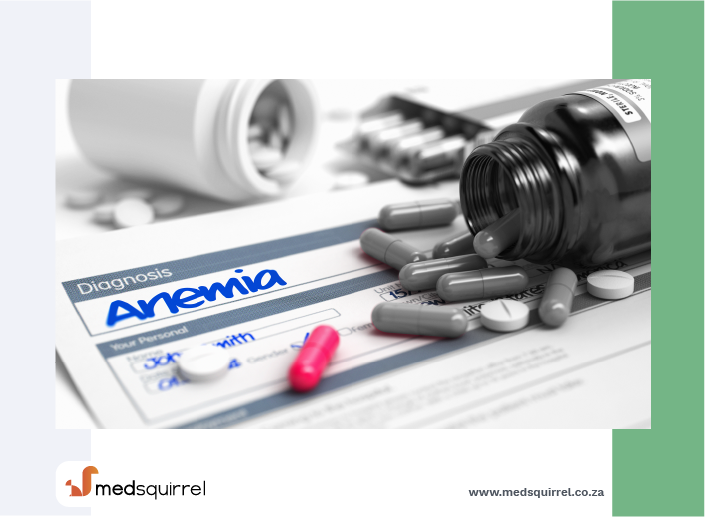Conditions Explained
Disclaimer:
This website is intended to assist with patient education and should not be used as a diagnostic, treatment or prescription service, forum or platform. Always consult your own healthcare practitioner for a more personalised and detailed opinion
Anaemia – Iron deficiency

We have selected the following expert medical opinion based on its clarity, reliability and accuracy. Credits: Cleveland Clinic, Ohio. Please refer to your own medical practitioner for a final perspective, assessment or evaluation.
Overview
What is iron?
Iron is a mineral in the human body. It is one of the components of haemoglobin, the substance in red blood cells that helps blood carry oxygen throughout the body.
If you do not have enough iron, your body cannot make haemoglobin, and you may develop anaemia, a disorder that occurs when there is not enough haemoglobin in the blood. When you develop anaemia, you are said to be "anaemic".
What is anaemia?
Anaemia is a blood disorder that occurs when there is not enough haemoglobin in a person's blood. Haemoglobin is a substance in the red blood cells that makes it possible for the blood to transport (carry) oxygen through the body.
There are a number of different types of anaemia. Some types present only mild health problems, while others are much more severe.
Each type of anaemia results from one of these factors:
- The body cannot make enough haemoglobin
- The body makes haemoglobin, but the haemoglobin doesn't work right
- The body does not make enough red blood cells
- The body breaks down red blood cells too fast
Who is most likely to develop iron-deficiency anaemia?
Anyone can develop iron-deficiency anaemia, although the following groups have a higher risk:
- Women: Blood loss during monthly periods and childbirth can lead to anaemia.
- Children, ages 1 to 2: The body needs more iron during growth spurts.
- Infants: Infants may get less iron when they are weaned from breast milk or formula to solid food. Iron from solid food is not as easily taken up by the body.
- People over 65: People over 65 are more likely to have diets that are low in iron.
- People on blood thinners
- People who have kidney failure: (especially if they are on dialysis), because they have trouble making red blood cells.
- People who have trouble absorbing iron
Causes
What causes anaemia?
Low levels of iron is the most common cause of anaemia. This is known as iron-deficiency anaemia, the most common type of anaemia.
Factors that can reduce the body's iron levels include:
- Blood loss (caused by ulcers, some cancers, and other conditions; and, in women, during monthly periods
- An iron-poor diet
- An increase in the body's need for iron (for instance, during pregnancy.
Diagnosis
How can I know if I have anaemia?
Your healthcare provider can perform blood tests to tell if you have anaemia. The type and number of blood tests will depend on what type of anaemia is suspected. Your healthcare provider will determine the proper treatment, depending on the type of anaemia and its cause.
Treatment
Can iron-deficiency anaemia be treated?
Yes. This type of anaemia can be treated and cured. First, your healthcare provider will determine if the anaemia is being caused by a poor diet or a more serious health problem. Then, you can be treated for both the anaemia and its cause.
Iron-deficiency anaemia is treated with iron supplements taken by mouth, or by eating foods that are high in iron.
What foods are high in iron?
The iron in food comes from two sources: animals and plants.
Iron from animal sources is known as haem iron and is found in various meats and fish. Iron from plants is known as non-haem iron and is found in certain vegetables and in iron-fortified foods such as breakfast cereals. Haem iron is better absorbed by the body than non-haem iron.
The following foods are good sources of haem iron (from animal sources):
- Chicken liver
- Oysters
- Clams
- Beef liver
- Beef (chuck roast, lean ground beef)
- Turkey leg
- Tuna
- Eggs
- Shrimp
- Leg of lamb
The following foods are good sources of nonheme iron (from plants):
- Raisin bran (enriched)
- Instant oatmeal
- Beans (kidney, lima, Navy)
- Tofu
- Lentils
- Molasses
- Spinach
- Whole wheat bread
- Peanut butter
- Brown rice
Try to combine nonheme iron foods with vitamin C (for example, a glass of orange juice) to increase absorption of iron.
Talk to your healthcare provider to determine how much iron you need every day.
_______________________________________________________________________________________________________________________
Are you a healthcare practitioner who enjoys patient education, interaction and communication?
If so, we invite you to criticise, contribute to or help improve our content. We find that many practicing doctors who regularly communicate with patients develop novel and often highly effective ways to convey complex medical information in a simplified, accurate and compassionate manner.
MedSquirrel is a shared knowledge, collective intelligence digital platform developed to share medical expertise between doctors and patients. We support collaboration, as opposed to competition, between all members of the healthcare profession and are striving towards the provision of peer reviewed, accurate and simplified medical information to patients. Please share your unique communication style, experience and insights with a wider audience of patients, as well as your colleagues, by contributing to our digital platform.
Your contribution will be credited to you and your name, practice and field of interest will be made visible to the world. (Contact us via the orange feed-back button on the right).